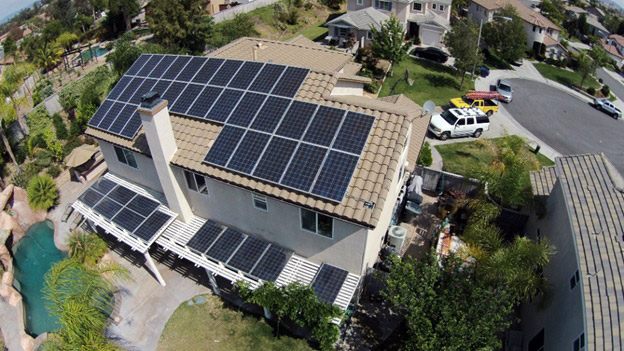Published at RenewableEnergyWorld.com --- Global solar installations will reach 64.7 GW in 2016 according to Mercom Capital Group, a clean energy communications and research firm based in Texas. “The top 3 countries will be China, U.S., and Japan and they will account for about two thirds of the global market,” said Raj Prabhu, CEO and co-founder of Mercom.
Although China is expected to continue leading the global PV market, the U.S. will show the most robust growth in 2016, due to the anticipation of the federal Investment Tax Credit (ITC) expiration, which developers and EPC had already factored into their business plans for 2016, prior to the five-year extension received at the end of 2015.
In 2016, the U.S. is set to overtake Japan as the second largest solar market, exceeding the much-anticipated 10-GW mark. Another notable shift will see India move up to the No. 4 position, pushing down the former European leaders, U.K. and Germany.
China: Remains No. 1 Market with Some Trouble Ahead
China is expected to install approximately 19.5 GW in 2016, a rise of 14.7 percent over 2015, Mercom predicts. “The country is strongly committed [to solar] because of the pollution problems. Air pollution continues to drive China’s environmental policies, of which clean power generation is a big part,” said Prabhu.
Officials from China’s National Energy Administration (NEA) are considering raising the 2020 target from 100 GW to 150 GW, which will bring about 21 GW of annual installation between 2016 through 2020. China also has pledged to reach an ‘emissions peak’ around 2030 with non-fossil fuels making up 20 percent of the nation’s energy generation mix. “All of these factors have made renewable forms of energy a vital component of the Chinese economy for years to come,” stated Prabhu.
The rapid PV deployment, however, has caused growing grid congestion problems. In addition, the nation’s economic conditions also deteriorated in 2015. “Production curtailment and subsidies continue to be the biggest challenges facing the Chinese solar industry. Subsidy payment delays up to 18 months have been reported by solar project developers causing cash flow problems. Some companies have reported selling out projects and stopping further project development activities as they are unable to sustain without timely subsidy payments,” said Prabhu....Read More Here
Latest solar PV and other renewable energy market developments - policies, new products/services, business models, and market players - in the US and Japan
January 26, 2016
米テキサス州の電力会社が「地元の太陽光100%プラン」 地元のメガソーラーから「環境価値」を購入
Published at Nikkei Technology Online --- 日本では4月から電力小売りが全面自由化され、一般家庭の電気利用者が初めて電力を「選択」できるようになる。米国では電力自由化は国レベルではなく、州レベルで決められ実行される。米国の中で最も電力自由化が進むといわれるテキサス州で、地域の太陽光発電を100%使った地産地消を促進する電力料金プランが、初めてお見えした。
テキサス州は電力の消費量が全米で最も多く、約378TWhに達する。この需要規模は、英国やスペインに匹敵する。同州はその消費量を賄うため発電量も多く、石油・ガス火力、さらに風力発電でも全米ナンバーワンを誇る。
こうした巨大な電力市場を持つテキサス州では、2002年に電力自由化が実施に移された。同州の自由化は、日本でこれから行われる自由化と似ている。従来、発電と送配電設備を所有していた大手電力会社を分割し、発電会社と送配電会社に分離した。電力小売りの自由化が進むなか、送配電事業は引き続き規制の下に置かれている。
現在、テキサス州では115社にも達する小売電気事業(REPと呼ばれる)が家庭、商業、産業向けに電力を販売している。これらの小売電気事業者は、送配電設備を所有する電力会社(全5社)の送配電ネットワークを利用して電力を供給する。...Read More Here
テキサス州は電力の消費量が全米で最も多く、約378TWhに達する。この需要規模は、英国やスペインに匹敵する。同州はその消費量を賄うため発電量も多く、石油・ガス火力、さらに風力発電でも全米ナンバーワンを誇る。
こうした巨大な電力市場を持つテキサス州では、2002年に電力自由化が実施に移された。同州の自由化は、日本でこれから行われる自由化と似ている。従来、発電と送配電設備を所有していた大手電力会社を分割し、発電会社と送配電会社に分離した。電力小売りの自由化が進むなか、送配電事業は引き続き規制の下に置かれている。
現在、テキサス州では115社にも達する小売電気事業(REPと呼ばれる)が家庭、商業、産業向けに電力を販売している。これらの小売電気事業者は、送配電設備を所有する電力会社(全5社)の送配電ネットワークを利用して電力を供給する。...Read More Here
January 12, 2016
米加州の「ネットメータリング」制度が改正へ 再エネの普及拡大と消費者の負担、バランスはどこに?
Published at Nikkei Technology Online --- 米国市場は2015年の年末ぎりぎりに連邦政府の「再生可能エネルギー導入投資税控除(ITC)」政策延長が可決され、さらなる太陽光発電市場の成長に明るい見通しが立った。しかし、米国の太陽光発電市場をリードするカリフォルニア州において、同州の太陽光発電市場の将来を左右する重要な州レベルの制度が未解決のまま年を超えた。
それは同州で分散型太陽光発電分野の普及を支えてきた「ネットメータリング(net-metering)」と呼ばれる制度である。「ネットメータリング」とは、分散型発電設備の所有者に対する電力料金の算定手法だ。住宅用などの分散型太陽光発電システムの発電量から、電力消費量を差し引いて余剰電力量が発生した場合、余剰分を次の月に繰り越せる、つまり、消費量を発電量で「相殺」する仕組みである(図1)。
この制度では、ネットメータリングの総設置容量に関し、法律で上限を定めている。上限は、「キャップ(CAP)」とも呼ばれる。ネットメータリングを活用する分散型太陽光発電システムの総設置容量が、キャップに達すると、電力会社は同システムの設置を基本的に拒否できるようになる。カリフォルニア州ではこの上限に近づいており、2015年に電力会社と太陽光発電を推進する企業やサポーター(支持者)間で同制度をめぐる論争が一段と激しくなった。
現在のネットメータリング制度は、発電量1kWhは電力購入の小売価格と同等で取り扱われていたが、カリフォルニア州の大手電力会社は「余剰電力買い上げ価格を下げる」、または「太陽光発電システムの所有者に特別の料金を課す」との方針を申請した。...Read More Here
それは同州で分散型太陽光発電分野の普及を支えてきた「ネットメータリング(net-metering)」と呼ばれる制度である。「ネットメータリング」とは、分散型発電設備の所有者に対する電力料金の算定手法だ。住宅用などの分散型太陽光発電システムの発電量から、電力消費量を差し引いて余剰電力量が発生した場合、余剰分を次の月に繰り越せる、つまり、消費量を発電量で「相殺」する仕組みである(図1)。
 |
| 図1●ネットメータリング制度を利用する住宅用システム。出力7.6kW(出所:Sullivan Solar Power) |
現在のネットメータリング制度は、発電量1kWhは電力購入の小売価格と同等で取り扱われていたが、カリフォルニア州の大手電力会社は「余剰電力買い上げ価格を下げる」、または「太陽光発電システムの所有者に特別の料金を課す」との方針を申請した。...Read More Here
Subscribe to:
Comments (Atom)